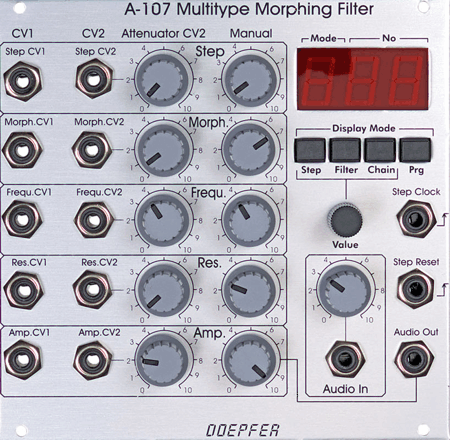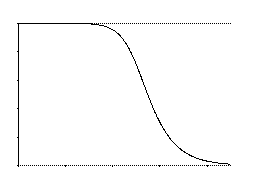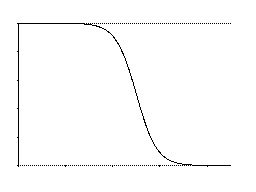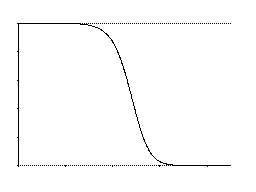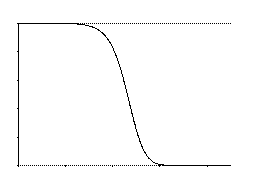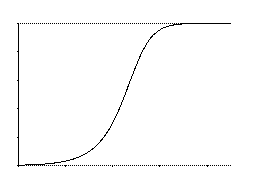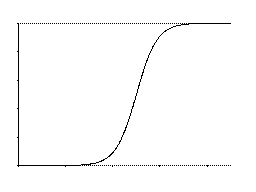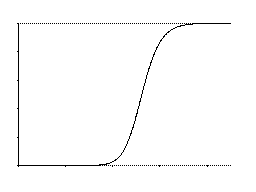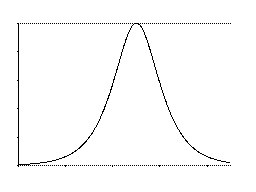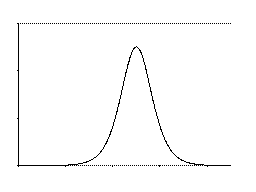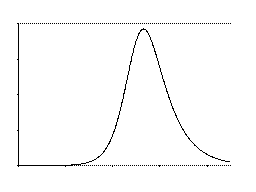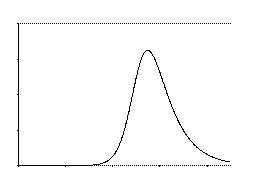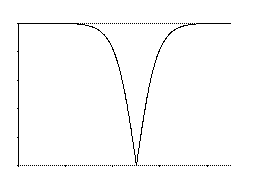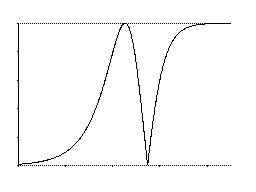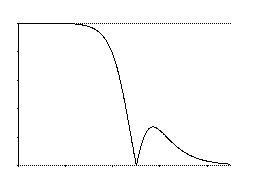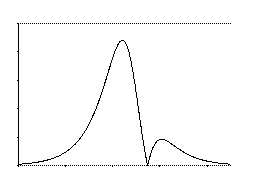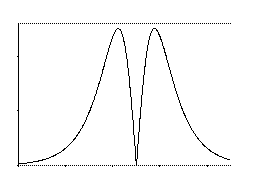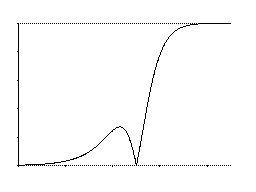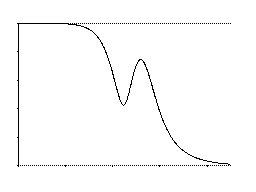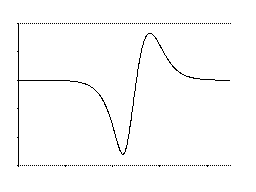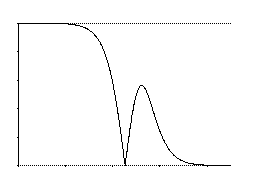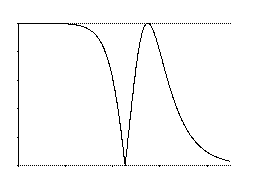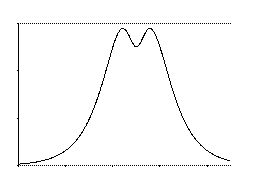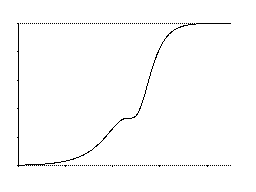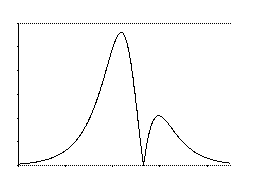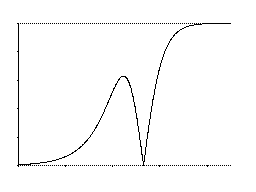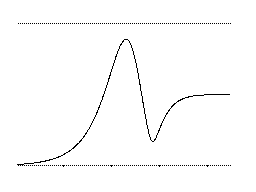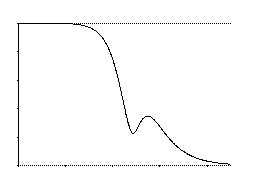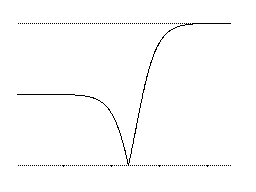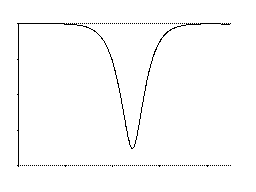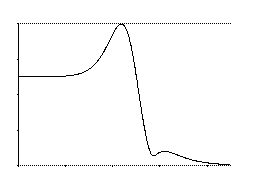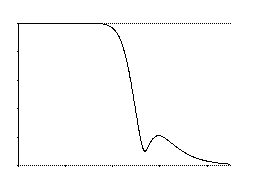|
A-107 Multitype
Morphing Filter |
|||||
|
Das Modul A-107 ist ein völlig
neuartiges spannungsgesteuertes Filter, das 36 verschiedene
Filtertypen
beinhaltet: verschiedene Tiefpässe, Hochpässe, Bandpässe, Notch-Filter,
Allpässe und spezielle Filterverläufe, die - zumindest bisher noch - keine
gängige Bezeichnung besitzen. Die Filtertypen sind in der Grafik am Ende dieser
Seite in Form von Frequenzgang-Kurven angegeben. Die Filter sind in zwei Gruppen
zu je 18 Filtern organisiert. Zwischen den verschiedenen Filter-Typen ist
innerhalb einer Gruppe ein stufenloser Übergang ("Morphing")
, aber auch ein harter
Übergang (umschalten) möglich.
Für beide Parameter ist jeweils
ein manueller
Regler, ein Steuerspannungseingang mit Abschwächer und ein Steuerspannungseingang
ohne Abschwächer verfügbar.
Zusätzlich ist eine "clocked" Betriebsart verfügbar, bei der die Filterstufen der momentan angewählten Filterkette über ein externes Clock-Signal (Buchse mit der Bezeichnung Step Clock) fortlaufend durchgeschaltet werden können. Ein positives Trigger-Signal am Reset-Eingang (Buchse mit der Bezeichnung Step Reset) schaltet auf den den ersten Filter der Filterkette zurück. Hiermit kann die Filterumschaltung beispielsweise synchron zu einer Sequenz erfolgen. Der bei jedem VCF übliche Frequenzregler
und zwei Steuereingänge für die Filterfrequenz (davon einer mit
Abschwächer) stehen natürlich auch zur Verfügung. Das Filterdesign ist 100% analog (CEM-Filterbaustein), nur die Morphing-Steuerung und die Speicherverwaltung übernimmt ein Microcontroller. Hinweis: Der Übergang von einer Filtergruppe (1...18 / 19...36) zu anderen ist aus technischen Gründen nur hart möglich (Umschaltung von Kondensatoren). Weiches Überblenden (Morphing) ist daher nur innerhalb einer Filtergruppe (d.h. innerhalb der Filter 1...18 oder 19...36) möglich. Werden nacheinander 2 Filter angewählt, die zu unterschiedlichen Filtergruppen gehören, ist wegen der Umschaltung der Kondensatoren ein kurzes Klick-Geräusch zu hören. Um in jedem Fall weiche Übergänge sicherzustellen, dürfen daher innerhalb einer Kette (Chain) nur Filter aus der selben Filtergruppe verwendet werden. Die deutsche Bedienungsanleitung ist als PDF-Datei
auf unserer Website verfügbar: Das Modul ist leider nicht mit blauem Display lieferbar, da das verwendete integrierte Display (Controller und 3-fach-Display als eine Einheit, Hersteller: Liteon) bisher nicht in blau erhältlich ist. |
||||
|
|
|||||
|
Module A-107 is a completely new voltage
controlled
filter that has available 36 filter types: different versions of low pass, high pass, band pass, notch, all pass and filters with new
response curves that have no name up to now. The frequency response curves of
the 36 filters available in the A-107 are shown in the graphics
at the end of this page. The filters are organized
in two groups of 18 filters each. The transition between different
filter types within one group can be soft (morphing) or hard
(switching).
For both parameters manual control, one CV input with attenuator and one CV input without attenuator are available. The 36 filter types can be arranged in filter chains (resp. filter sequencer or filter orders) so that this sequence of filters is passed through while the control voltage changes from 0...+5V. Each chain consists of 32 steps. 64 filter chains can be programmed by the user and stored in the non-volatile memory of the module. The following controls are used to program the filter chains:
Additionally a "clocked" mode is available. This means that the steps of the currently selected filter chain are selected one after another. Each positive transition of the Clock signal calls up the next filter of the chain (jack socket marked Step Clock). A positive trigger at the Step Reset input (jack socket marked Step Reset) resets to the first filter of the current filter chain. This allows e.g. to switch between the filters of the currently selected filter chain in sync with a sequencer. Of course the standard VCF controls are available: manual filter frequency control,
one CV input with attenuator and one CV input without attenuator. On top of it a final VCA is available (even with manual control, CV input with attenuator and CV input without attenuator). The filter design is 100% analog (CEM filter chip). Only the morphing control and memory managing is carried out by a microcontroller. Remark: Because of technical reasons the transition between the two filter groups (1...18, resp. 19...36) cannot be carried out soft as capacitors have to be switched. Soft transition (i.e. morphing) is possible only within the filter group (i..e. within the filters 1...18 or 19...36). Switching between filters causes a "click" if the filters are from different groups. For more detailed information please look at the
English user's manual Sorry, the A-107 is not available with blue display as the integrated 3-digit display (combined controller and triple display, manufacturer: Liteon) used is not available in blue color so far.. |
||||
|
|
|||||
|
Breite: 26 TE / 131.8 mm Tiefe: 40 mm (gemessen ab der Rückseite der Frontplatte) Strombedarf: +200mA (+12V) / -60mA (-12V) |
Width: 26 HP / 131.8 mm Depth: 40 mm (measured from the rear side of the front panel) Current: +200mA (+12V) / -60mA (-12V) |
||||
|
|
|||||
|
Preis: 300.00 Euro nicht mehr lieferbar |
Price: 300.00 Euro no longer available The price in US$ depends upon the exchange rate between Euro and US$ at the payment day. |
||||
